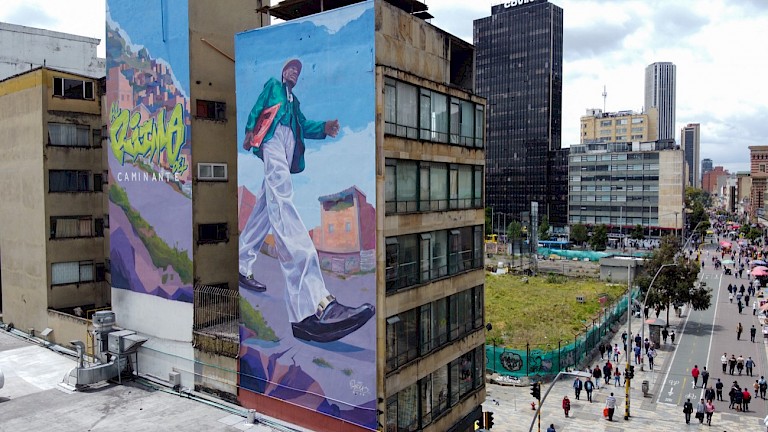



In collaboration with the Secretaria de Cultura Recreación y Deporte (the Secretary of Culture, Recreation, and Sports) and the Instituto Distrital de Patrimonio Cultural (District Institute of Cultural Heritage), IDARTES (District Institute of Art) created a program to promote urban art and to create cultural activations along the city of Bogota.
Having in mind the crucial role of representation in urban art, the project worked through open calls for artists to submit their artwork ideas during the year. The call was open to everyone interested in sharing their artistic ideas. The call is organised by IDARTES and its related organisations such as the Santa Fe Gallery, who work together to generate awareness about local art.
The artists are selected through the Programa Distrital de Estímulos (District Program of Stimulus) through which a pool of experts (who have previously applied to the program) are selected to evaluate the proposals submitted by artists and choose the ones that best respond to the open call. The jury is required to have experience in the field, publications about the subject matter, plus have previous experience as evaluators. Once the selection of artists and projects is met, each of them is provided with a grant to develop their work in public and open spaces determined in the selection process. Most of the artworks provide the public with individual and collective narratives that can converse with each other promoting the culture and history of the city.
Every open call is meant for a specific sector of the city to enhance the nature, culture, and history of that area. For instance, murals close to the wetlands around the city showcase their beauty and importance, while others take a more political stance incentivising the care of these places. Each project is assigned a grant of about 38 million pesos (approx. 9,000 USD) to be developed. Each of the winning artists or collectives is accompanied by a team from IDARTES to get the needed permissions to paint the streets.
They are also required to meet with the pedagogical MAB team to make sure their work is addressing the community and communicating the assigned message clearly. Additionally, they are required to record a short video of the community engagement processes and address art-led urbanism, place-making, community building, or social practice that they developed during the creation of their work. The program has an online gallery with all the murals that have been created so far along the streets of Bogota for anyone around the globe who is interested in seeing the exemplary urban art that characterises the city of Bogota.
This project has largely contributed to the cultural activation of the city by supporting urban art. The light it has brought upon street art has inspired young artists to get closer to the art world and it has also improved community engagement through creativity and culture.
The artist Jorge Restrepo describes the process of one of the first murals as a special one: the artist made workshops with the community that lives and works nearby to collect ideas that reflected the neighbourhood. They came up with images and words that were brought together to create his final vision. Since the piece was made under a bridge, the collaboration was developed with the Institute of Urban Development (IDU) and lights were added under the bridge, plus the appropriate transit signage was integrated into the project; with the changes made, the safety of the area increased tremendously.
The MAB has proven to decrease the crime rate in the intervened areas by 41% according to the Secretary of Security, Coexistence and Justice. It has also increased tourism in the city, particularly in the historic centre and it has created art-led urbanism. After seeing tons of graffiti around the city, Christian Petersen, an Australian who decided to move to Bogota years ago, created the Bogota Graffiti Tour. He is also an artist and uses this platform to tell people the history of Bogota's urban art.
Peterson talks about how many more tourists come to the city yearly interested in the urban art of the country. He also says that Bogota has some of the best urban art he has seen, and he attributes it to the freedom the city provides to the artists.
The MAB has reactivated areas that were previously unattended or forgotten with every project. Together with the idea of supporting urban art, IDARTES created pedagogical programs to accompany the works of art. Among these are city tours, workshops, and the MAB pedagogical booklet. All initiatives help the public to engage with the art individually and collectively.
Bogota’s Open Museum (MAB in Spanish) is a commitment and opportunity created by the District Institute of the Arts of Bogotá - IDARTES to promote the visual arts through the active and purposeful participation of the citizens who live in Bogotá in the conception, execution and public exhibition of actions and artistic interventions that have the street or public space as the setting for their staging.
The MAB is a museum open to the visit, at any time and from any of the twenty districts in Bogotá, of individual and collective narratives expressed and put into community in the public space through the visual arts, with which artists and communities are invited to build their territories and environments together.
MAB aims to socially and culturally transform the environments of Bogota, as a catalyst for knowledge, attitudes, emotions, and practices of citizens in public spaces, destigmatising the practice of street art. It provides different perspectives and views of the city, generating spaces for discussion, debate, and collective construction. The MAB seeks to build social fabric by strengthening the links of citizens and artistic communities around the creation and appreciation of public art.




